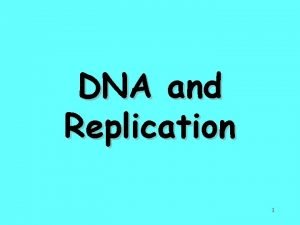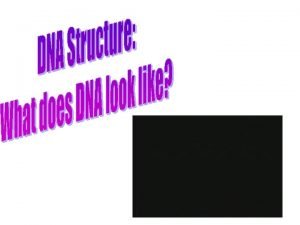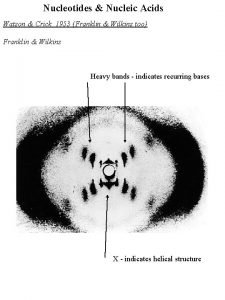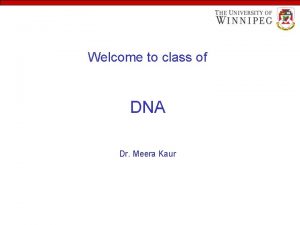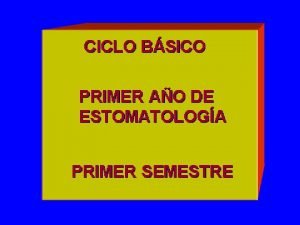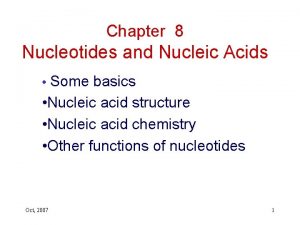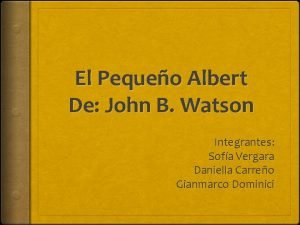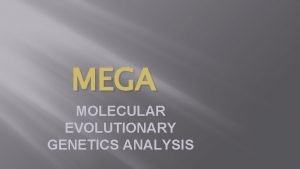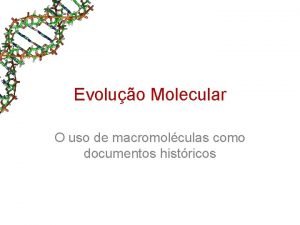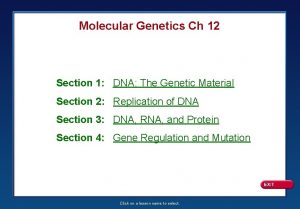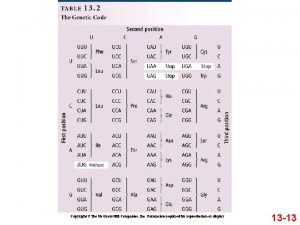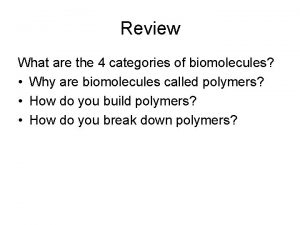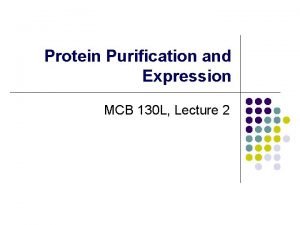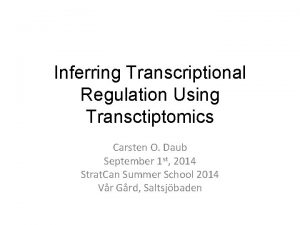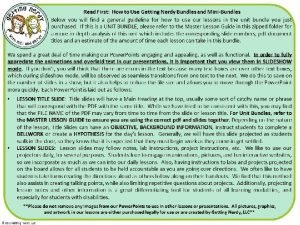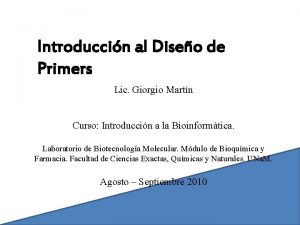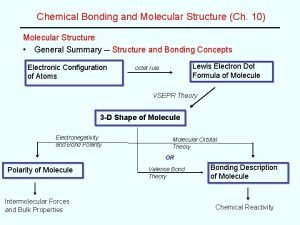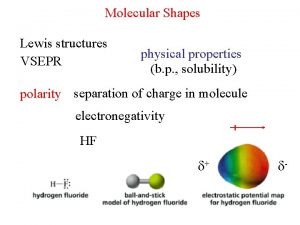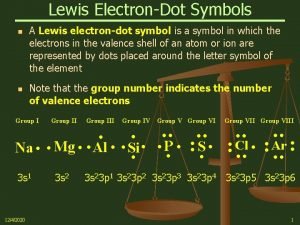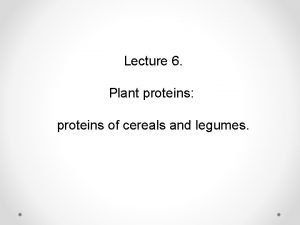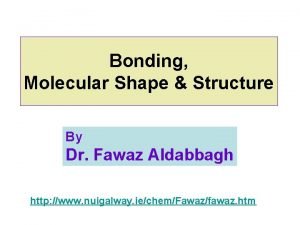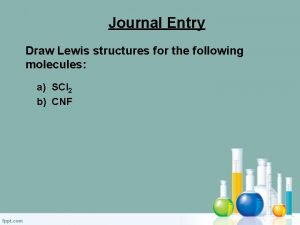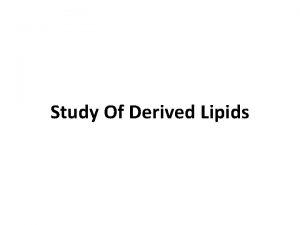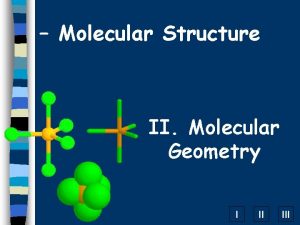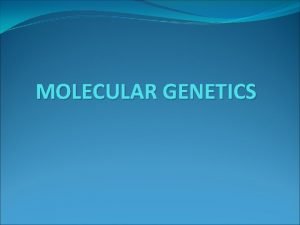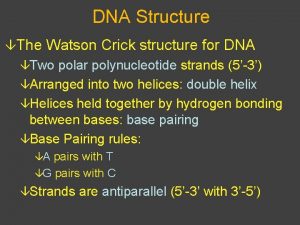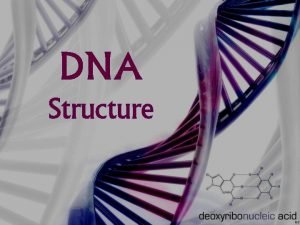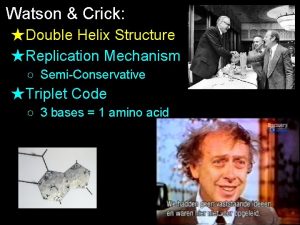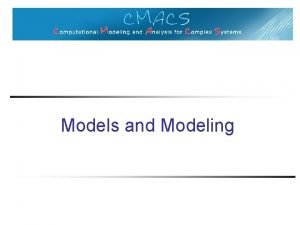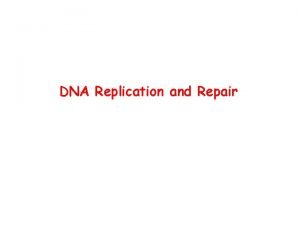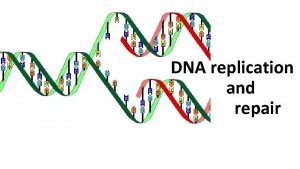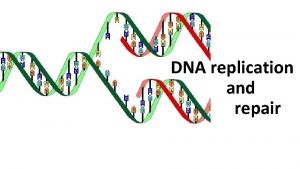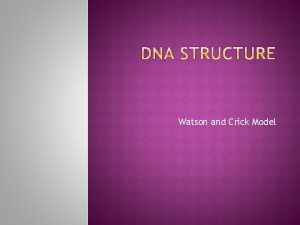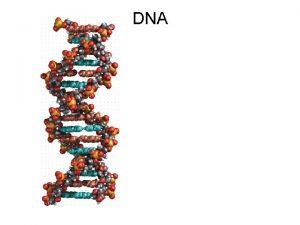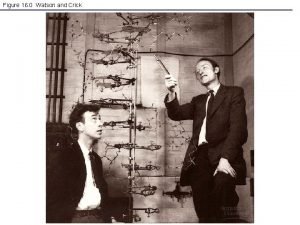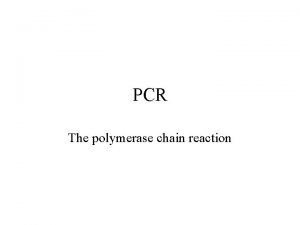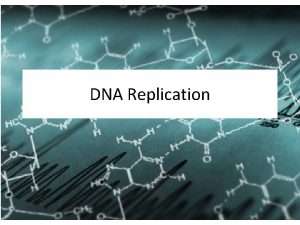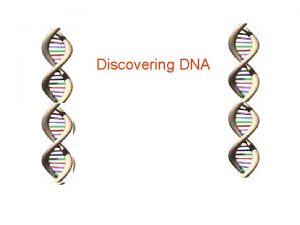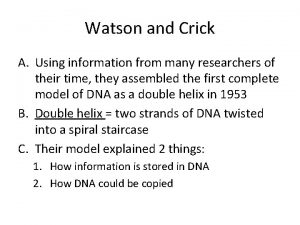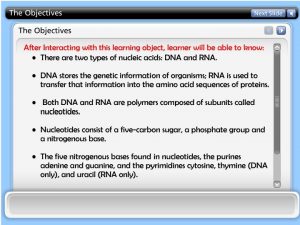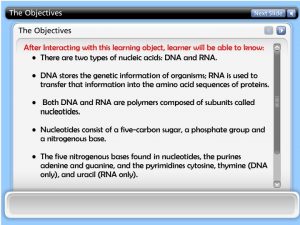MOLECULAR GENETICS Watson and Crick The structure of













































































- Slides: 77

MOLECULAR GENETICS

Watson and Crick The structure of DNA was described by British Scientists Watson and Crick as long double helix shaped with its sugar phosphate backbone on the outside and its bases on inside; the two strand of helix run in opposite direction and are antiparallel to each other. The DNA double helix is stabilized by hydrogen bonds between the bases.

Watson and Crick discovers DNA Feb 28 th 1953

DNA A purine always links with a pyrimidine base to maintain the structure of DNA. Adenine ( A ) binds to Thymine ( T ), with two hydrogen bonds between them. Guanine ( G ) binds to Cytosine ( C ), with three hydrogen bonds between them.

Nucleic acid probe Nucleic acid fragment, labelled by a radioisotope, biotin, etc. , that is complementary to a sequence in another nucleic acid (fragment) and that will, by hydrogen binding to the latter, locate or identify it and be detected; a diagnostic technique based on the fact that every species of microbe possesses some unique nucleic acid sequences which differentiate it from all others, and can be used as identifying markers or "fingerprints. "

Nucleic acid probe Nucleic acid fragment, labelled by a radioisotope, biotin, etc. , that is complementary to a sequence in another nucleic acid (fragment) and that will, by hydrogen binding to the latter, locate or identify it and be detected; a diagnostic technique based on the fact that every species of microbe possesses some unique nucleic acid sequences which differentiate it from all others, and can be used as identifying markers or "fingerprints. "

Hybridization probe is a fragment of DNA or RNA of variable length (usually 100 -1000 bases long), which is used to detect in DNA or RNA samples the presence of nucleotide sequences (the DNA target) that are complementary to the sequence in the probe. The probe thereby hybridizes to single-stranded nucleic acid (DNA or RNA) whose base sequence allows probe-target base pairing due to complementarily between the probe and target. Dr. T. V. Rao MD 7

Nucleic Acid Probes Accu probes from Gene probe, which contains a chemiluminescent label and target the r. RNA of the microorganisms of interest. It reads events in vivo or during the multiplication of organism.

DNA is Endless structure The rungs of the ladder can occur in any order (as long as the base-pair rule is followed) Those 4 bases have endless combinations just like the letters of the alphabet can combine to make different words.

DNA Replication DNA replication is semi -conservative. That means that when it makes a copy, one half of the old strand is always kept in the new strand. This helps reduce the number of copy errors. So we remained what we were ?

So we remained what we were Because of Our Genetic Materials

DNA to RNA DNA remains in the nucleus, but in order for it to get its instructions translated into proteins, it must send its message to the ribosome's, where proteins are made. The chemical used to carry this message is Messenger RNA

TYPES OF BLOTTING TECHNIQUES Blotting technique Southern Blot Northern Blot Western blot It is used to detect DNA. It is used to detect RNA. It is used to detect protein.

Nucleic Acid Hybridizations �The hybridization of a radioactive probe to filter bound DNA or RNA is one of the most informative experiments that is performed in molecular genetics. Two basic types of hybridizations are possible. �Southern hybridization - hybridization of a probe to filter bound DNA; the DNA is typically transferred to the filter from a gel �Northern hybridization - hybridization of a probe to filter bound RNA; the RNA is typically transferred to the filter from a gel

Western blotting is an Immunoblotting technique which rely on the specificity of binding between a molecule of interest and a probe to allow detection of the molecule of interest in a mixture of many other similar molecules. In Western blotting, the molecule of interest is a protein and the probe is typically an antibody raised against that particular protein. The SDS PAGE technique is a prerequisite for Western blotting.

Western Blotting

Restriction fragment length polymorphism Sir Alec Jeffreys developed restriction fragment length polymorphism (RFLP), which quickly became the standard technique for DNA testing throughout the 1980 s. RFLP provided the world with the first form of genetic testing based on DNA, the body's genetic material

Restriction Fragment Length Polymorphism (RFLP) is a technique in which organisms may be differentiated by analysis of patterns derived from cleavage of their DNA.

RFLP The resulting DNA fragments are then separated by length through a process known as agarose gel electrophoresis, and transferred to a membrane via the Southern blot procedure.


Spoligotyping �Spoligotyping, a new method for simultaneous detection and typing of M. tuberculosis complex bacteria, has been recently developed. This method is based on polymerase chain reaction (PCR) amplification of a highly polymorphic direct repeat locus in the M. tuberculosis genome.

Spoligotyping in Tuberculosis The well-conserved 36 bp direct repeats are interspersed with unique spacer sequences varying from 35 to 41 bp in size. Clinical isolates of MTC bacteria can be differentiated by the presence or absence of one or more spacers.

Results analyzed by Computer

DNA finger printing Every one of our DNA is equal except for only about 0. 10 %. DNA finger printing lies in uniqueness of those regions of DNA that do differ from person to person. Only 5 % of our DNA code rest do not code called in past as Junk DNA and contain repeated sequences of base pairs Called as Variable number of tandem repeats contain 20 to 100 base pairs and the same sequence is repeated one to 3 times in a row

Documentation of Finger printing for Records Finger print means translating all the variable number of tandem repeats to visible records All VNTR is tested for restriction length polymorphism which differ from species to species. All the obtained material is blotted to Nylon or Nitrocellulose membrane ( Southern Blotting )

RLFP to PCR Isolation of sufficient DNA for RFLP analysis is timeconsuming and labour intensive. However, PCR can be used to amplify very small amounts of DNA, usually in 2 -3 hours, to the levels required for RFLP analysis. Therefore, more samples can be analysed in a shorter time.


Molecular diagnostics – how it works Every organism contains some unique, species specific DNA sequences Molecular diagnostics makes the species specific DNA visible

PCR methods are rapid and sensitive PCR, as a specific, sensitive and rapid technique in the identification of the pathogen in the clinical specimen has been developed extensively over the past decade. Its value as a clinical tool is being increasingly recognized

Polymerase Chain Reaction Methodology A Mile stone in Medical History He had the idea to use a pair of primers to bracket the desired DNA sequence and to copy it using DNA polymerase, a technique which would allow a small strand of DNA to be copied almost an infinite number of times.

Dr. Kary Mullis, wins Nobel Prize in 1993 Kary received a Nobel Prize in chemistry in 1993, for his invention of the polymerase chain reaction (PCR). The process, which Kary Mullis conceptualized in 1983, is hailed as one of the monumental scientific techniques of the twentieth century.


PCR Liberates a Innocent Prisoner �Kirk. Bloods worth case �A Waterman �Imprisoned for 9 years on wrong evidences of Rape �Unmatched DNA by PCR makes a freeman

Locates Genes for Color Blindness Color Blind British John Dalton died in 1844 Request his eyes to be preserved And to be investigated why he confused scarlet with green, and pink with blue Recent PCR studies prove Dalton lacked a gene for making one of the three photo pigments essential for normal color vision.

Color Blindness is x linked The genes for our red and green colour receptors are located on the X-chromosome, giving women a redundant set of receptor genes. This is why men are far more prone to colourblindness than women.

DNA – RNA - DNA In Molecular biology, the polymerase chain reaction (PCR) is a technique to amplify a single or few copies of a piece of DNA across several orders of magnitude, generating millions or more copies of a particular DNA sequence.

Common Tools of Molecular Biology Nucleic acid fractionation Polymerase chain reaction Probes, Hybridization Vector, Molecular cloning Nucleic acid enzymes Microarray DNA sequencing Electrophoretic separation of nucleic acid Detection of genes: *DNA: Southern blotting; in. Situ hybridization; FISH Technique *RNA: Northern blotting *Protein: Western blotting, immunohistochemistry

Current Uses of molecular Biology The most recent applied technologies, genetic engineering, DNA finger-printing in the social and forensic science, pre and postnatal diagnosis of inherited disease, gene therapy and drug Design. Molecular biology allows the laboratory to be predictive in nature, it gives information that the patients may be at risk for disease (future). Major tool in Diagnosis of Infectious

Restriction Endonulease �If two organisms differ in the distance between sites of cleavage of a particular restriction endonuclease, the length of the fragments produced will differ when the DNA is digested with a restriction enzyme. The similarity of the patterns generated can be used to differentiate species (and even strains) from one another.

Restriction Endonulease Restriction endonucleases are enzymes that cleave DNA molecules at specific nucleotide sequences depending on the particular enzyme used. Enzyme recognition sites are usually 4 to 6 base pairs in length. The recognition sequences are randomly distributed through the DNA and recognizes different nucleotide sequences, and snips through DNA molecule.

Taq polymerase �Taq polymerase is a thermos table DNA polymerase named after thermophilic bacterium Thermus aquaticus from which it was originally isolated by Thomas D. Brock in 1965. It is often abbreviated to "Taq Pol" (or simply "Taq"), and is frequently used in polymerase chain reaction (PCR), methods for greatly amplifying short segments of DNA

Disadvantages of Taq Pol Taq mis-incorporates 1 base in 104. A 400 bp target will contain an error in 33% of molecules after 20 cycles. Error distribution will be random.

Thermo cycler is Back bone of PCR methodology �The method relies on thermal cycling, consisting of cycles of repeated heating and cooling of the reaction for DNA melting and enzymatic replication of the DNA

PCR - Three basic Steps Cut Paste mplify A

PCR Primers TTAACGGCCTTAA. . . TTTAAACCGGTT AATTGCCGGAATT. . > and <. . AAATTTGGCCAA TTAACGGCCTTAA. . . TTTAAACCGGTT

Cutting, pasting and amplifying is the basis of Reaction

Denaturing Template Heat causes DNA strands to separate 5’ 3’ 3’ 5’ Denature DNA strands 94 o. C 5’ 3’ 3’ 5’

Annealing Primers • Primers bind to the template sequence • Taq Polymerase recognizes double-stranded substrate 5’ 3’ 3’ 5’ Primers anneal 64 o. C 5’ 3’ 3’ 5’ 5’

Taq Polymerase Extends • Taq Polymerase extends primer • DNA is replicated 3’ 5’ 3’ 3’ 5’ 5’ Extend 72 o. C 5’ 3’ 3’ 5’ 5’ Repeat denaturing, annealing, and extending 30 cycles

Molecular diagnostics is a set of methods to study primary structure (sequence) of DNA • Hybridization with complementary sequences -A-A-T-T-C-G-A-T-G- T-T-A-A-G-C-T-A-C- • Amplification (synthesis) of species specific sequences PCR – polymerase chain reaction -A-A-T-T-C-G-C-G-A-T-G-A-A-T-T-C-G-C-G-A-T-G-A-A-T-T-C-G-A-T-GThe 7 th Baltic Congress in Laboratory Medicine, Pärnu 11. 09. 2004

PCR occurs in cycles and Multiplies the DNA


Applications of PCR The standard specimen procedure can quantitate HIV 1 RNA in a range of 40075, 000 copies/m. L.

Advantages of PCR Speed Ease of use Sensitivity

Candida infections can be specifically identified The fragments of 125 -bp (EO 3) and 317 bp (HSP) specific for C. albicans were used for amplification.

Molecular methods proving highly Sensitive It has been postulated that DNA sequencing of the universal nested PCR product may allow identification of the causative organisms in a number of culture are few

PCR helps in several critical Conditions PCR has also been evaluated in the diagnosis of fungal endophthalmitis using broad range primers as well as primers specific for C. albicans. Detection of fungal DNA by PCR in intraocular specimens will prove as a useful means of diagnosing endophthalmitis. It will greatly facilitate management decisions when conventional culture is negative.

Advantages Molecular methods • High sensitivity and specificity • Detects pathogen, not immune response • Quick results • High transport toleration In-house (home-brew) PCR methods • Cost effective • High sensitivity • High quality • Fast implementation of scientific discoveries • Customer friendly The 7 th Baltic Congress in Laboratory Medicine, Pärnu 11. 09. 2004


QIAGEN One Step RT-PCR Kit The QIAGEN One Step RT-PCR Kit is designed for easy and sensitive one-step RT-PCR using any RNA template. A unique enzyme combination and specially developed reaction buffer ensure efficient reverse transcription and PCR in one tube.

RT-PCR in one step The Robus™ T I Kit is base Robus. T RT-PCR Kits perform c. DNA synthesis and PCR amplification of c. DNA successively in a single tube during a continuous thermal cycling

Nested polymerase chain reaction �Nested polymerase chain reaction is a modification of polymerase chain reaction intended to reduce the contamination in products due to the amplification of unexpected primer binding sites. � Nested polymerase chain reaction involves two sets of primers, used in two successive runs of polymerase chain reaction, the second set intended to amplify a secondary target within the first run products

Loop Mediated Isothermal Amplification (LAMP) �Loop mediated isothermal amplification is a simple, rapid, specific and cost effective nucleic acid amplification method characterized by use of 8 distinct regions on the target gene. �The amplification proceeds at a constant temperature using strand displacement reaction.

Multiplex PCR Taq. Man probes and Molecular beacons allow multiple DNA species to be measured in the sample ( Multiplex PCR) since fluorescent dyes with different emission spectra may be attached to different probes

Multiplex PCR in Real Time �Multiplex real time quantitative RT-PCR assays have been developed for simultaneous detection identification and quantification of HBV, HCV and HIV! �In plasma and Serum samples.

Prevention of Contamination in PCR Laboratory �PCR contamination be considered as a form of infection. If standard sterile techniques that would be applied to tissue culture or microbiological manipulations are applied to PCR, then the risk of contamination will be greatly reduced. Above all else, common sense should prevail.

Polymerase Chain Reaction Available for several infections …. Chlamydia trachomatis Slow growing Mycobacterium tuberculosis viruses like Herpes simplex virus , Varicella Zoster virus. Adeno virus in our laboratory for corneal specimens

Uses and Advantages in Testing by PCR Methods Clinical diagnostics: detection and quantification of infectious microorganisms, cancer cells and genetic disorders Capable of amplifying long targets, up to 6. 0 kb One-tube system allows rapid, sensitive and reproducible analysis of RNA with minimal risk of sample contamination Amplifies products from a wide variety of total RNA or m. RNA sources

Disadvantages of PCR Methods Expensive to the Developing world Need well trained, Manpower Coordination for quality control Adoption to changing needs Timely technical support False positive results due to Amplifications

Over 1400 molecular pathology labs in the US, with bulk of genetic testing being provided by a few big labs. Large Labs: Quest Diagnostics Lab. Corp Genzyme Medium Labs: Mayo ARUP (Associated Regional and University Laboratories Pathologist) MD Anderson Regional clinics and hospital Laboratories Key End User product feature requirements: Clinical Practicality of test Strong client portfolio and relationship with laboratories Result turnaround time

Important issue in genetic testing market is deciding which testing platform or technology will have highest adoption rates in Clinical labs Technology issues are throughput, sample concentration, procedure sensitivity and specificity Economic issues are costs of instrument and reagents, current platforms available in the lab, and ease of use of the procedures Genetic testing looks for genetic marker such as Single Nucleotide Polymorphism (SNP) , Restriction Fragment length Polymorphism (RFLP) or short tandem repeat (STR) Theoretically any marker can be identified through any of the platforms Real- Time Polymerase Chain Reaction ( RTPC) Capillary Electrophoresis Micro-array Multiplexing Instruments

Important issue in genetic testing market is deciding which testing platform or technology will have highest rates in Clinical labs Technology issues are throughput, sample concentration, procedure sensitivity and specificity Economic issues are costs of instrument and reagents, current platforms available in the lab, and ease of use of the procedures Genetic testing looks for genetic marker such as Single Nucleotide Polymorphism (SNP) Restriction Fragment length Polymorphism (RFLP), or Short tandem repeat (STR) Theoretically any marker can be identified through any of the platforms Real- Time Polymerase Chain Reaction ( RTPC) Capillary Electrophoresis Micro-array Multiplexing Instruments

�Electrophoresis Platform: �A method of detection for specific gene sequences using gel electrophoresis �Currently high availability of electrophoresis instrumentation in labs means that kits designed for this platform should have the most rapid uptake. �Least expensive- $15 K US for state of the art equipment �Electrophoresis also offers low costs per tests - kit cost $80/patient �Versatile in number of different application �Major disadvantage is labor intensity

�RT-PCR Platform: �A method for rapid and simultaneous amplification, detection and quantification of gene fragments or gene expression �Slower adoption than electrophoresis due to the cost of machinery - $30 K �Expected to have significant uptake because of prevalence in SNP testing �Currently many specialty labs like Quest Diagnostics have high RT-PCR usage �Cost expected to drop

�Microarray Platform: �A method for rapid detection of multiple simultaneous gene fragments or gene expression. Probes that react to patient’s genetic material are arranged in grid pattern on glass or plastic platform. Resulting matches constitute a positive test, which are readily identifiable. �Most Expensive $150 K-$180 K + $500 per test �Reaction indicate particular genetic sequences, such as those related to diseases, or how people will respond to certain medications. Microarrays also can enable researchers to see which genes are being switched on and off under different medical conditions. �Currently does not have many clinical applications, so drawback for laboratories to invest in platform �Roche’s Ampli. Chip is only FDA approved microarray test for diagnostic use

�Multiplexing Platform: �A method for simultaneous detection of specific gene fragments, gene expression, immune response proteins and enzymes. Multifunction beads are manipulated to bind and signal the specific presence of a a variety of substrates �More versatile than microarray �Allows more variation with regards to type of test - up to 100 assays to be preformed simultaneously on one sample. �Slower than competing technologies however �Multiplexing technology are expected to gain field. �FDA awarded its first approval for a CF diagnostic test to TM Bioscience’s multiplexing platform based test.

Regulatory Issues FDA regulates reagents, kits and instruments sold to and performed by clinical labs. Diagnostic tests can be sold as Analyte Specific Reagents (ASR) to highly sophisticated CLIA-certified labs. FDA exercised restrain in regulating home- brew tests performed by these labs. No specific clinical, validity or performance claims are allowed for unregulated ASRs. Potential liabilities if a lab chooses to provide an ASR rather than a 510(k)-cleared alternative. Receiving a 510(k) FDA approval is a significant market barrier: Four FDA approved genetic diagnostic tests: Roche Ampli. Chip, used to individualize dosage of antidepressants, antipsychotics, beta-blockers, and some chemotherapy drugs TM Bioscience (Toronto, Canada) TAG-IT assay for detecting cystic fibrosis Visual Genetics (Toronto, Canada acquired by Bayer in ‘ 02) TRUGENE HIV-1 Genotyping Kit, used to detect variations in the genome of the human immunodeficiency virus that make the virus resistant to some anti-retroviral drugs. Third Wave’s Invader assay detects variations in a gene that produces the enzyme UDPglucuronosyltransferase, and predicts adverse events. http: //www. fda. gov/cdrh/oivd/index. html http: //www. fda. gov/cder/genomics/default. htm
 Watson and crick thieves
Watson and crick thieves Watson and crick
Watson and crick Watson and crick
Watson and crick Watson and crick model of dna
Watson and crick model of dna Modelo de watson y crick
Modelo de watson y crick James dewey watson y francis harry compton crick
James dewey watson y francis harry compton crick Phosphoanhydride bond
Phosphoanhydride bond Watson strand crick strand
Watson strand crick strand Physical state of covalent compounds
Physical state of covalent compounds Giant molecular structure vs simple molecular structure
Giant molecular structure vs simple molecular structure Zinc oxide + nitric acid → zinc nitrate + water
Zinc oxide + nitric acid → zinc nitrate + water Pap protein synthesis worksheet
Pap protein synthesis worksheet John watson james broadus watson
John watson james broadus watson John broadus watson emma watson
John broadus watson emma watson John b watson conductismo
John b watson conductismo Mary ickes watson
Mary ickes watson Section 14-3 human molecular genetics answers
Section 14-3 human molecular genetics answers Chapter 12 section 1 molecular genetics answer key
Chapter 12 section 1 molecular genetics answer key Chapter 12 molecular genetics
Chapter 12 molecular genetics Mega molecular
Mega molecular Arvore filogenetica
Arvore filogenetica Chapter 12 section 1 dna the genetic material
Chapter 12 section 1 dna the genetic material Molecular genetics chapter 12
Molecular genetics chapter 12 Francis crick nationality
Francis crick nationality Enzyme
Enzyme Quaternary structure of protein
Quaternary structure of protein Differential centrifugation
Differential centrifugation Francis crick
Francis crick Francis crick
Francis crick Primers degenerados
Primers degenerados Smar crick
Smar crick Smrt crick
Smrt crick Theory of structures
Theory of structures Electron dot structure of ethene
Electron dot structure of ethene Bond order examples
Bond order examples Ch2o lewis structure molecular geometry
Ch2o lewis structure molecular geometry Hno2 lewis structure molecular geometry
Hno2 lewis structure molecular geometry Lentils examples
Lentils examples O3 lewis structure molecular geometry
O3 lewis structure molecular geometry Nocl3 lewis structure
Nocl3 lewis structure The shape of ab3e
The shape of ab3e Non essential fatty acids
Non essential fatty acids Molecular structure
Molecular structure Hát kết hợp bộ gõ cơ thể
Hát kết hợp bộ gõ cơ thể Ng-html
Ng-html Bổ thể
Bổ thể Tỉ lệ cơ thể trẻ em
Tỉ lệ cơ thể trẻ em Gấu đi như thế nào
Gấu đi như thế nào Thang điểm glasgow
Thang điểm glasgow Chúa yêu trần thế alleluia
Chúa yêu trần thế alleluia Các môn thể thao bắt đầu bằng tiếng đua
Các môn thể thao bắt đầu bằng tiếng đua Thế nào là hệ số cao nhất
Thế nào là hệ số cao nhất Các châu lục và đại dương trên thế giới
Các châu lục và đại dương trên thế giới Công của trọng lực
Công của trọng lực Trời xanh đây là của chúng ta thể thơ
Trời xanh đây là của chúng ta thể thơ Mật thư anh em như thể tay chân
Mật thư anh em như thể tay chân 101012 bằng
101012 bằng Phản ứng thế ankan
Phản ứng thế ankan Các châu lục và đại dương trên thế giới
Các châu lục và đại dương trên thế giới Thể thơ truyền thống
Thể thơ truyền thống Quá trình desamine hóa có thể tạo ra
Quá trình desamine hóa có thể tạo ra Một số thể thơ truyền thống
Một số thể thơ truyền thống Cái miệng xinh xinh thế chỉ nói điều hay thôi
Cái miệng xinh xinh thế chỉ nói điều hay thôi Vẽ hình chiếu vuông góc của vật thể sau
Vẽ hình chiếu vuông góc của vật thể sau Thế nào là sự mỏi cơ
Thế nào là sự mỏi cơ đặc điểm cơ thể của người tối cổ
đặc điểm cơ thể của người tối cổ Thứ tự các dấu thăng giáng ở hóa biểu
Thứ tự các dấu thăng giáng ở hóa biểu Vẽ hình chiếu đứng bằng cạnh của vật thể
Vẽ hình chiếu đứng bằng cạnh của vật thể Vẽ hình chiếu vuông góc của vật thể sau
Vẽ hình chiếu vuông góc của vật thể sau Thẻ vin
Thẻ vin đại từ thay thế
đại từ thay thế điện thế nghỉ
điện thế nghỉ Tư thế ngồi viết
Tư thế ngồi viết Diễn thế sinh thái là
Diễn thế sinh thái là Các loại đột biến cấu trúc nhiễm sắc thể
Các loại đột biến cấu trúc nhiễm sắc thể Số nguyên tố là gì
Số nguyên tố là gì Tư thế ngồi viết
Tư thế ngồi viết Lời thề hippocrates
Lời thề hippocrates
